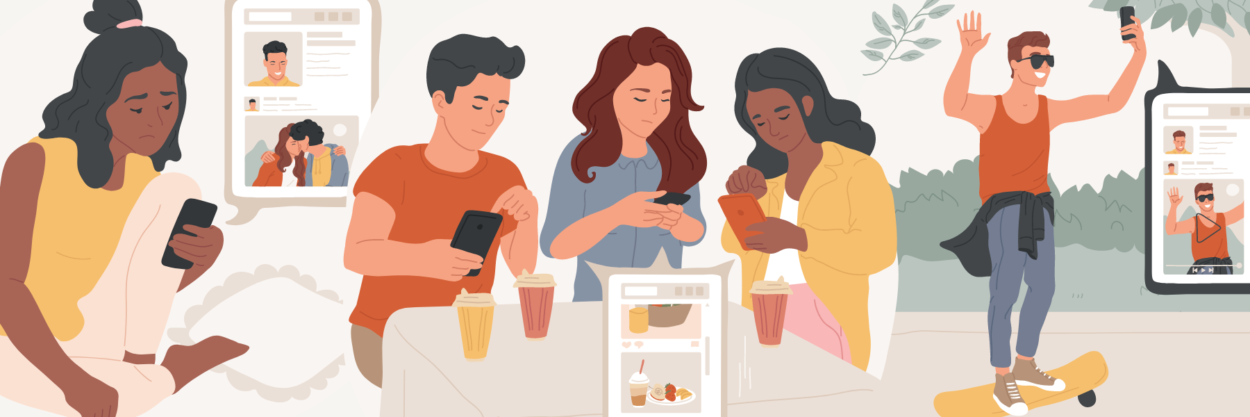It is estimated that around 90% of teenagers aged between 13 and 17 in the United States of America have accounts on social media platforms. Globally, as per a 2023 tech report, around 4.76 billion people actively use social media. Social media enables individuals to create, share, or exchange information and ideas in virtual communities and networks. Some of the most popular social media platforms include Facebook, X formerly Twitter, Instagram, WhatsApp, Discord, TikTok, and YouTube, amongst others.
Teenagers are often the early adopters of social media platforms and are among the first to utilise and popularise new ones, like TikTok. While social media has its downsides, caregivers find it challenging to set boundaries for teenagers while allowing them to utilise 21st-century technology. It is an essential part of teenagers’ professional and social development, but it also brings online dangers such as misinformation, cyberbullying, and connecting with dangerous strangers.
How do teenagers perceive social media, and how do they achieve a balance?
Below, two students from Sint Maarten Academy, Akeelah Mills (17) and DeSjaniah Lake (14), share their insights on the positives and negatives of social media:
Akeelah Mills (17): “Social Media allows me to connect with my friends and people from around the world.
To me, social media is a way to connect with friends, express creativity, and stay updated on what’s happening in the world. I enjoy seeing my friends’ photos and updates and sharing my experiences. I use platforms such as Pinterest, WhatsApp, Instagram, Snapchat, and TikTok to find inspiration and share thoughts, ideas, and moments with others.
One of the positives I experience is the ability to connect with people from all over the world and build new friendships. Social media has made it easier to stay in touch with friends, even if we’re far apart. It’s also a great way to discover new interests and communities and learn from others.
However, social media does have its negatives. Sometimes, it can lead to comparing ourselves to others and feeling pressure to present a perfect image. It’s crucial to prioritise our mental well-being and not let social media negatively impact our self-image. It’s important to remember that what we see on social media is often curated and fake, which doesn’t always reflect reality.
When I come across social media content, I verify its authenticity before accepting it as true. One of the first things I do is check the source of the content. If it’s from a reputable news organisation or a verified social media account, I’m more likely to trust it. However, if it’s from an unknown or unverified source, I approach it with caution and by not being influenced easily. I know some content on social media can be fake, so I try not to compare myself to it.
When it comes to choosing what content I see or share, I follow accounts that inspire and uplift me. I also make sure to engage with posts that promote positivity, inclusivity, and understanding. By actively curating my social media feed, I can create a more positive and supportive online environment. Although I don’t put my accounts in private, I do “filter out” who I talk to online to keep myself protected because there are a lot of creeps on the internet. I also limit posting personal information such as the area I live, the school I attend, etc.
If I were blocked from social media, it would likely have a significant impact on my daily life. Social media platforms have become essential for my communication, staying updated on news and trends, and connecting with friends. Being cut off from these platforms would make it challenging for me to stay connected with my loved ones, keep up with current events, and participate in online discussions and communities that I enjoy. It might also affect my ability to access certain services or information that are primarily available through social media channels.
Overall, social media is a part of our lives and social experiences in many ways. It allows us to stay connected with friends, share experiences, and create memories together. Whether it’s planning trips, sharing funny moments, or supporting each other, social media can enhance our friendships and make our social experiences more engaging.”
DeSjaniah Lake (14): “Cyberbullying is one of the negative sides to social media.
Social media can be a good and bad thing. To me, social media is a platform that most people turn to, and they use it for different purposes. Some positives I experienced are learning new ways to study, cooking hacks, and learning about various professions. You can choose the content you watch and share. I mostly share funny or Christian videos because that’s the content I watch.
Social media is a part of everyone’s life. We use it every day to contact our friends, for a business service, or even just for entertainment. It also is used in negative ways. For instance, death threats and cyberbullying. I myself have personally dealt with cyberbullying, which caused me to fall into depression, but I didn’t tell my parents because I thought they wouldn’t care.
To overcome the negativity, I took a week-long break from the internet and focused on the good things in life, like the actual friends that I have. Another thing I did to cope with it was to write down my feelings. I wrote stories and took out my anger on the characters I created. I feel that cyberbullying and death threats are unnecessary things to do or say to someone. It wouldn’t make them feel good, and they might get worse…
One way that parents can help is to try to bond more with their kids to keep them safe. Yes, parents should check their children’s phones from time to time, but they should also teach them about dangerous things on the internet. Over everything, our mental health always comes first. To help teens, parents should give their children an electronic-free day and check up on their mental health. This way they can give their kids a day to just relax and be themselves. It can also help prevent addiction to social media. The parents should do this at least 2-3 days a month to make sure their child knows they can talk to their parents about stuff.”
Find our poster on how to help protect children from online bullying on our downloads page!


